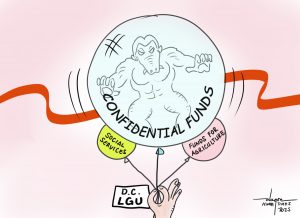 “YES to SIDC (Samal Island-Davao City) Bridge;
“YES to SIDC (Samal Island-Davao City) Bridge;
Yes to realignment;
NO to environmental destruction;
NO to serious legal violations!
WE build with nature as one!”
The above is some kind of a battle cry by the Rodriguez-Lucas families, owners of Paradise Island Resort and the Costa Marina Resort in Caliclic, Island Garden City of Samal in their bold effort to save a De Facto marine sanctuary now threatened to annihilation with the planned Davao City-Samal Island Connector Bridge supposed to have been started many months ago as announced but postponed indefinitely for quite vague reasons. Lately however, it is already obvious that the main factor of the delay is the issue of funding the project. Earlier when the decibel of the noise about the start of its construction in April of 2021 it was banded around that the government of China would have been the source of a loan for the project implementation
Unfortunately, after many months of “silence” the bad, or most likely good to some, news is that shortly after the end of the term of former Davaoeno President Rodrigo Duterte, it was announced by the Chinese government that it was withdrawing its funding commitment. Nonetheless one thing that can be considered as “light at the end of the tunnel” is that under the new administration the possibility of renegotiating for the loan is strong.
And as the “battle cry” states, the Rodriguez-Lucas families are a big YES to the bridge construction. Therefore they, too is hoping that such an economic booster will push through. However, they are strongly against the current route proposed to be taken by the multi-billion peso modern span. First, it would mean that its area will be steamrollered once the Samal end of the bridge will be built. And second, it would mean the total annihilation of the under-water biodiversity long protected by the two families as part of their commitment to help preserve nature in that part of the earth.
By the way, we have in our possession some important documents regarding the stalled (or is it failed?) construction of the Samal- Davao City connector bridge on time as committed. The latest of these documents are the result of a study on the reefs in a stretch fronting the two resorts, more focused on its marine diversity situation, and a research paper by a well-known environmentalist. For lack of material time to fully read and comprehend the contents of the various documents we will treat this instead in our succeeding columns for the benefit of people who seem not to understand why the bridge still remains a nebulous dream until now and why are some people who strongly agree that the connector span will result to the development of the island city but still appear to be against its construction at its current location as proposed by a Hong Kong-based consulting firm that conducted the latest of several feasibility studies on the project.
Of course the oppositions – not of the bridge but its desired route to be taken – have cited lapses in the feasibility study and the failure of certain Philippine government agencies to look into environmental considerations as the primary causes of its rejection of the bridge passage.
They seem not to mind the reported bloating of the project cost with the change of location as compared to the cost of the span in its earlier feasibility study conducted by the Japan International Cooperation Agency or JICA where the location of the bridge would have cost lower than what it is now as proposed by the new consulting group.
But that is what could happen when political and business interests will have gone to its point of agreement. And the bridge is the meeting point.
Sorry for those who are into the business interest side but not part of the loop of politics. They can be considered “sacrificial” lambs in the clash of titans.
Meanwhile, the sudden problem of financing the Samal-Davao City connector bridge might be one temporary respite for the “at risk” resort businesses of the Rodriguez and Lucas families. At least, for the time being, they can still think of finding legal remedies and other strategies to save their businesses and the marine sanctuary they so carefully maintain at its current ideal state.
The danger that they must foresee is the possibility that the government will adopt the idea that in determining development projects it has to consider the number of beneficiaries against the number of potential sufferers. This could hit them right on the head.


